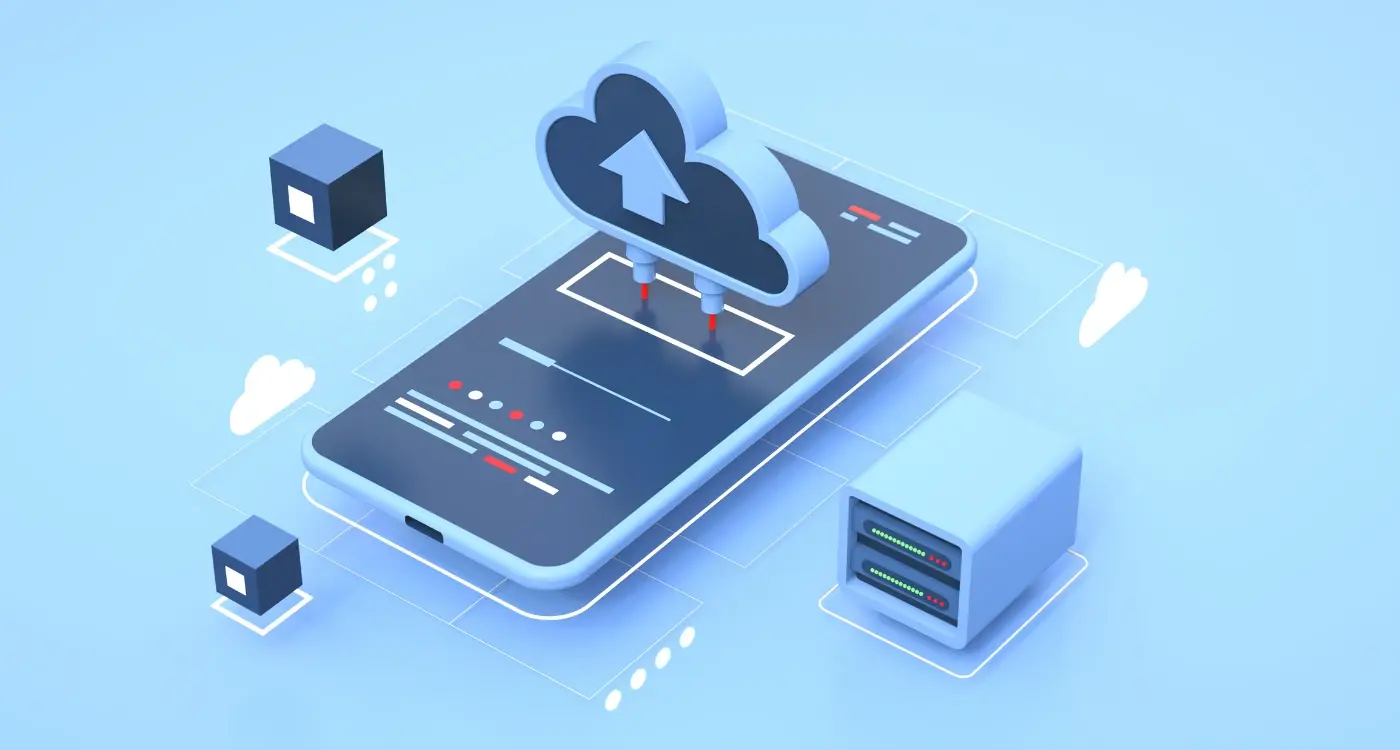How Difficult Is It to Build a Serverless Mobile App Backend?
The global app economy is worth over £365 billion annually—and yet most mobile app developers still struggle with one particular challenge: building a reliable backend. You know, that invisible part of your mobile app that handles data storage, user authentication, and all the behind-the-scenes magic that makes your app actually work.
I've been working with mobile app development teams for years, and the same question keeps coming up: "How hard is it really to build a serverless backend?" The short answer? It depends entirely on what you're trying to build and what skills you already have. But here's the thing—serverless doesn't automatically mean easier, even though that's what most people assume.
Building a serverless mobile app backend is like assembling furniture without instructions—technically possible, but you'll save yourself hours of frustration if you know what you're doing beforehand
The truth is, serverless architecture has changed the game for mobile app backend development. Gone are the days when you needed to manage servers, worry about scaling, or spend sleepless nights troubleshooting infrastructure issues. But—and this is a big but—serverless brings its own set of challenges that catch many developers off guard. From understanding event-driven architecture to managing cold starts and debugging distributed systems, there's quite a bit to wrap your head around. That's exactly what we'll explore in this guide: the real technical difficulty behind building a serverless mobile app backend, what skills you'll actually need, and how long it takes to get everything working properly.
What Is A Serverless Mobile App Backend?
A serverless mobile app backend is a way to build the behind-the-scenes parts of your mobile app without managing your own servers. Think of it like renting individual services when you need them, rather than buying and maintaining an entire computer system. The name "serverless" is a bit misleading though—there are still servers involved, you just don't have to worry about them.
With traditional backends, you'd need to set up servers, keep them running, update them, and scale them up when more people use your app. That's a lot of work and expense. Serverless changes this completely. Instead of running your own servers 24/7, you write small pieces of code called functions that only run when someone actually uses your app.
How Serverless Functions Work
When someone opens your app and wants to log in, your serverless function springs to life, processes the login, then goes back to sleep. You only pay for those few milliseconds it was actually working. If a million people use your app at the same time, the cloud provider automatically creates more copies of your function to handle the load.
The main serverless services that power mobile apps include:
- Functions that run your code (like AWS Lambda or Google Cloud Functions)
- Databases that store user data and app content
- Authentication services for user logins and security
- File storage for photos, videos, and documents
- Push notification services
Why Choose Serverless for Mobile Apps
Serverless backends are particularly good for mobile apps because they can handle unpredictable usage patterns. Your app might have 10 users one day and 10,000 the next—serverless scales automatically without you lifting a finger. You also don't need to become a server management expert, which means you can focus on building great app features instead.
Understanding The Technical Skills You'll Need
Let's be honest about what you're getting yourself into. Building a serverless mobile app backend isn't something you can tackle with just basic coding knowledge—though it's not as scary as some developers make it sound either. The technical difficulty really depends on what skills you already have and how complex your app needs to be.
At the core, you'll need solid programming skills in at least one backend language. JavaScript is probably your best bet since it works across most serverless platforms, but Python and Go are also popular choices. Don't worry if you're not fluent in all three; pick one and get comfortable with it first.
Core Technical Requirements
Here's what you absolutely need to know before you start:
- API development and RESTful services
- Database design (both SQL and NoSQL)
- Authentication and security principles
- Cloud platform basics (AWS, Google Cloud, or Azure)
- Version control with Git
Don't try to learn everything at once. Master the basics first, then add complexity as your project grows.
What About The Learning Curve?
If you're coming from traditional backend development, serverless concepts might feel a bit strange at first. You're not managing servers anymore—instead, you're thinking about functions, triggers, and events. It's a different mindset but not necessarily harder.
The trickiest part is usually understanding how all the serverless pieces fit together. Your mobile app needs to talk to your functions, which might trigger other functions, which connect to databases and external services. Getting that flow right takes practice, but once it clicks, you'll wonder why you ever bothered with traditional servers.
Planning Your Backend Architecture
Right, let's get into the meat of things. Planning your serverless backend isn't something you want to wing—trust me on this one. I've seen too many projects go sideways because developers jumped straight into coding without thinking through the architecture first.
The good news? Serverless architecture actually makes planning simpler than traditional backends. You don't need to worry about server management or scaling infrastructure. Instead, you focus on breaking your app's functionality into small, independent functions that can run on their own.
Core Components to Plan For
Your serverless backend will typically need these building blocks, and planning each one properly will save you headaches later:
- API Gateway for handling requests from your mobile app
- Lambda functions (or equivalent) for your business logic
- Database services for storing user data and app content
- Authentication services to manage user logins
- File storage for images, videos, or documents
- Push notification services
Start by mapping out what your app actually does. Does it need user accounts? Will users upload photos? Do you need real-time messaging? Each feature will require specific serverless components, and understanding this upfront prevents you from discovering gaps halfway through development.
Security and Data Flow
Here's where many people trip up—they plan the happy path but forget about security and error handling. Your architecture needs to account for how data flows between services, what happens when things go wrong, and how you'll protect user information. Serverless doesn't mean server-less security!
The key is keeping things modular. Each function should do one job well, which makes your entire system easier to debug, update, and scale as your app grows.
Common Challenges You'll Face During Development
Right, let's talk about the bumps in the road. Building a serverless mobile app backend isn't all smooth sailing, and I'd be doing you a disservice if I didn't mention the challenges you'll likely encounter. These aren't meant to scare you off—they're just part of the journey that every developer faces.
The biggest headache? Cold starts. When your serverless functions haven't been used for a while, they go to sleep. When a user tries to access your mobile app, there's a delay while the function wakes up again. This can make your app feel sluggish, which isn't great for user experience. The good news is there are ways around this, but it does require some extra planning and sometimes a bit more cost.
Debugging Gets Tricky
Debugging serverless functions is quite different from debugging traditional backend development. You can't just run everything locally and step through your code line by line. Instead, you're often relying on logs and monitoring tools to figure out what went wrong. This takes some getting used to, and you'll need to get comfortable with cloud-based debugging tools.
The hardest part about serverless development isn't the code itself—it's learning to think differently about how your application runs and scales
Managing State and Data
Since serverless functions are stateless, you can't store information between requests like you might with a traditional server. This means you need to think carefully about how you handle user sessions, temporary data, and connections to databases. It's not impossible, but it does require a different approach to how you structure your mobile app backend.
Tools And Services That Make Building Easier
Building a serverless mobile app backend doesn't mean you need to write everything from scratch—and you definitely shouldn't! There are loads of brilliant tools and services designed to make your life easier, and using them is often the difference between a project that takes months versus one that takes weeks.
The big cloud providers offer comprehensive serverless platforms that handle most of the heavy lifting for you. AWS Lambda, Google Cloud Functions, and Azure Functions let you run your code without managing servers, whilst their databases like DynamoDB or Firestore store your data reliably. These platforms come with built-in scaling, monitoring, and security features that would take ages to build yourself.
Backend-as-a-Service Solutions
If you want something even simpler, Backend-as-a-Service platforms like Firebase, Supabase, or AWS Amplify can get you up and running incredibly quickly. They provide authentication, databases, file storage, and APIs through easy-to-use interfaces—perfect if you're not a backend expert but need professional results.
Development and Monitoring Tools
For the actual building process, tools like Postman help you test your APIs, whilst GitHub Actions or GitLab CI can automate your deployments. Monitoring tools such as Datadog or New Relic let you keep an eye on performance once your app is live, catching problems before your users notice them.
The secret is choosing tools that match your skill level and project requirements. Start simple with managed services, then add complexity only when you need it. Most successful projects use a combination of these tools rather than trying to do everything with just one platform.
How Long Does It Actually Take To Build?
Right, let's get straight to the point—everyone wants to know how long building a serverless mobile app backend will actually take. The short answer? It depends on what you're building and how experienced you are with backend development. But that's not very helpful, is it?
For a simple backend with basic user authentication and data storage, you're looking at around 2-4 weeks if you know what you're doing. That's assuming you're working on it consistently and have solid technical skills. If you're new to serverless architecture, add another week or two for learning and inevitable mistakes.
Breaking Down The Timeline
Here's what typically takes the most time during development:
- Setting up your serverless functions and database connections (3-5 days)
- Building user authentication and security features (4-7 days)
- Creating your API endpoints and data handling (5-10 days)
- Testing everything works properly with your mobile app (3-5 days)
- Debugging and fixing issues you didn't expect (2-4 days)
More complex backends with features like real-time messaging, file uploads, or payment processing can easily stretch to 6-8 weeks. The technical difficulty ramps up quickly when you start adding advanced features.
Start with the absolute minimum features your mobile app needs to function, then add complexity later. You'll save weeks of development time and reduce headaches.
Don't forget to factor in time for proper testing and deployment setup. Many developers underestimate this part, but it's where things often go wrong. Budget at least 20% extra time for unexpected issues—trust me, they always pop up when you least expect them.
Conclusion
Building a serverless mobile app backend isn't as scary as it might seem at first glance. Yes, there's a learning curve—you'll need to get comfortable with cloud services, understand how functions work, and wrap your head around event-driven architecture. But the good news? You don't need to be a server management expert or worry about scaling infrastructure.
The technical skills required are manageable for most developers. If you can write code and understand basic API concepts, you're already halfway there. The planning phase is probably more important than the coding itself—getting your architecture right from the start will save you weeks of headaches later on.
Those challenges we talked about? Cold starts, debugging distributed systems, vendor lock-in—they're real, but they're not insurmountable. Every technology has its trade-offs, and serverless is no different. The tools available today make the development process much smoother than it was just a few years ago. AWS Lambda, Google Cloud Functions, and Azure Functions have matured significantly.
Timeline-wise, expect a few weeks for a simple backend, maybe a couple of months for something more complex. That's assuming you're learning as you go. Once you've built one serverless backend, the next one becomes much quicker.
The real question isn't whether it's difficult—it's whether serverless fits your project's needs. For most mobile apps, especially those just starting out, the benefits of automatic scaling, reduced operational overhead, and pay-per-use pricing make serverless an attractive option. The difficulty is temporary; the benefits last throughout your app's lifecycle.
Share this
Subscribe To Our Learning Centre
You May Also Like
These Related Guides

How Do I Set up Automatic Scaling for My App's Cloud Infrastructure?

What Are The Biggest Benefits Of Serverless For Mobile Apps?



